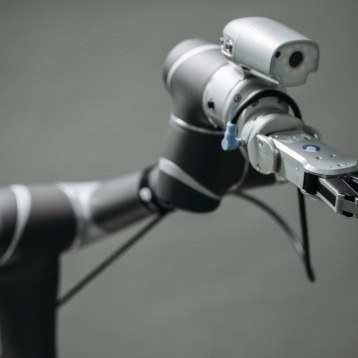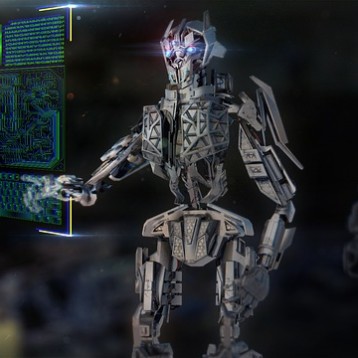A team of European researchers lead by scientists at the Institute of Process Control and Robotics in Karlsruhe, Germary are developing automated ant-like robots capable of collectively acting in a large group to accomplish tasks beyond the capability of a single robot. They propose that their creation could be used to explore Mars and make it ready for human habitation. Called I-SWARM, the robots can already act cohesively in groups of 100, communicating directly with each other to perform the small corrections and maneuvers necessary for collective actions.
Each robot in the system is a 2 millimeter by 2 millimeter by 1 millimeter stack of components piled on top of three 0.2 millimeter long legs controlled by a piezoelectric polymer actuator. The layers of components include a small, customized application specific integrated circuit (ASIC), an onboard solar panel providing power to the other systems, a communication unit facilitating communication with other robots in the swarm, and a small GPS unit. Each robot also has a vibrating cantelever sensor (VCS) attached to simulate an extra leg. This sensor should be the first element of a robot to touch another robot or external obstacles, preventing undesired collisions.
The swarm is designed to operate without a central director or external communications to a controller system. The actions of individual component robots are controlled through carefully designed swarm mathematics designed both to accomplish specific tasks within programmed scenarios and to provide positional information at any time. In addition, a certain number of cycles are devoted to collision avoidance.
The goal is to create two types of I-SWARM robots. About 20% of the robots in a swarm will be scouts – robots that actively search for goals or obstacles, and the rest will be worker robots, or robots who report to specific positions chosen by the scouts. It may not be possible to fully achieve this role separation during initial deployments, in which case all robots would fill both roles.
Current iterations of the I-SWARM robots can successfully complete five simple scenarios including even distribution of scouts throughout a specified area, even distribution of worker robots throughout a specified area, exploration of a specified area in search of up to two particular geographic locations (and several variations on the theme), moving worker robots to a specified location, and finding the shortest path between two specified points.
There are no current plans to deploy I-SWARM robots on Mars (or anywhere else), but exploration and colonization are well suited to a collective capable of self-adjusting its mission parameters and specific instructions to deal with whatever situations are encountered. The level of redundancy possible with such a swarm, particularly the ability to readjust and carry on if one or more robots are damaged or destroyed, make them particularly suited for highly dangerous and unknown situations likely to be encountered on such missions.
TFOT has reported on other biomimetic robots including the GhostSwimmer aquatic spy vehicle, a jumping robot inspired by grasshoppers, and a spy plane inspired by bats. In addition, TFOT has covered another collective robotics system consisting of voltage-controlled microelectromechanical microbots and another robotics system capable of swarm behaviors.
You can read more about the I-SWARM robots including their technical capabilities, project goals, and photographs here.
Image: P. Corradi.










